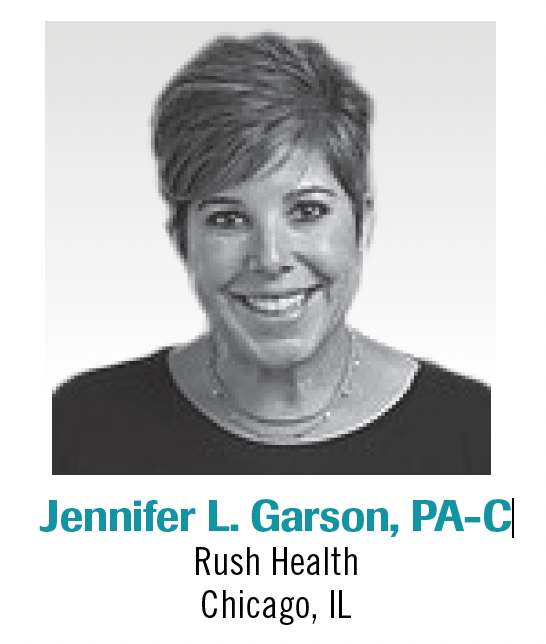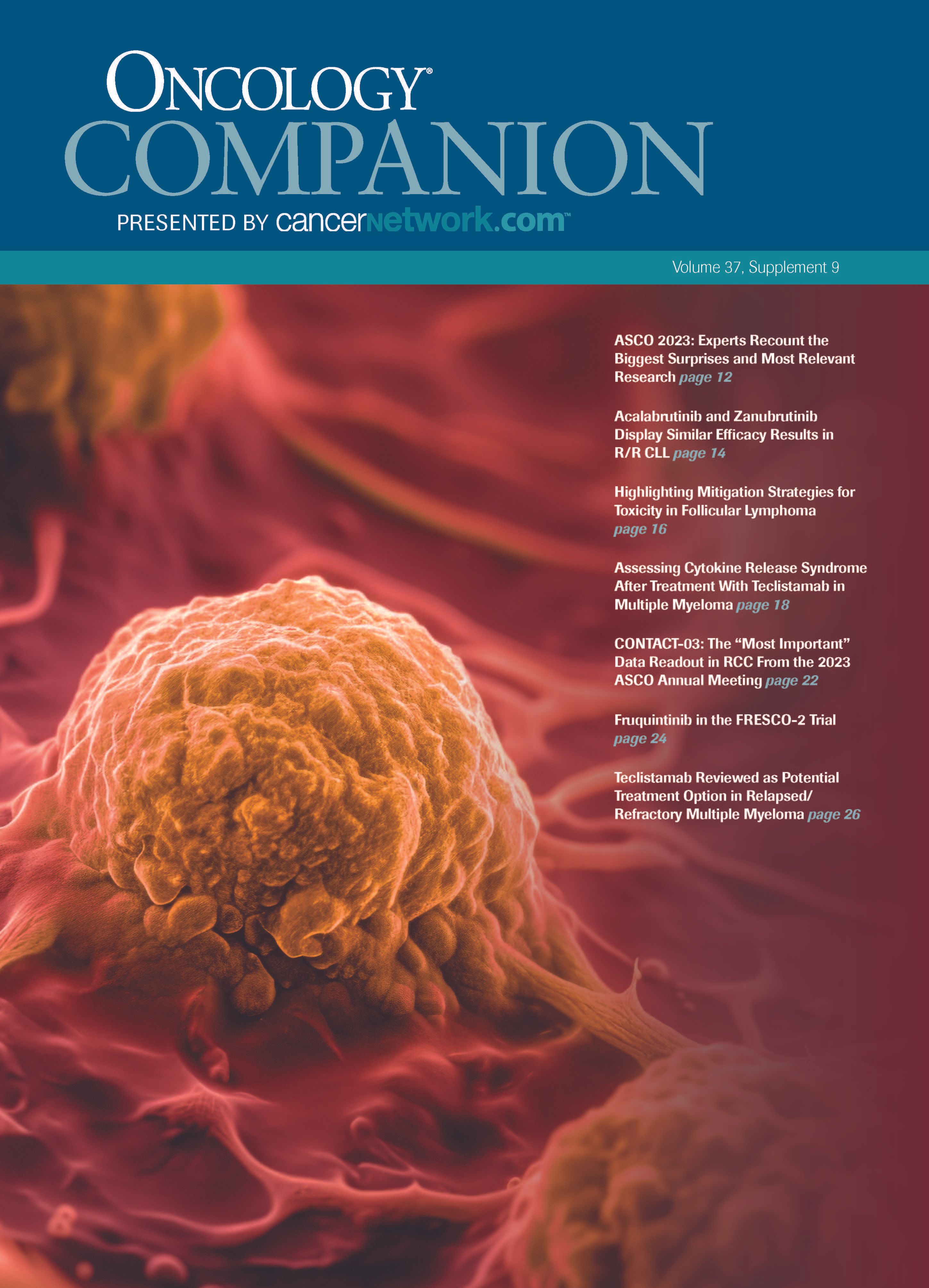Highlighting Mitigation Strategies for Toxicity in Follicular Lymphoma
Jennifer L. Garson, PA-C, gave an overview of follicular lymphoma and how she manages adverse effects in her institution.
During a live discussion from the 2023 American Society of Clinical Oncology (ASCO) Annual Meeting, Jennifer L. Garson, PA-C, sat down with CancerNetwork® to review the treatment landscape in follicular lymphoma. This discussion stemmed from an Around the Practice® panel she took part in with her colleagues that focused on both the present standard of care and the emerging therapies on the horizon for
follicular lymphoma.
Jennifer L. Garson, PA-C, a physician’s assistant with Rush Health in Chicago, Illinois

Garson, a physician’s assistant with Rush Health in Chicago, Illinois, also elaborated on her role as part of a multidisciplinary care team. She touched upon the unmet needs in follicular lymphoma and the biggest takeaway she drew from her discussion with her colleagues during the panel.
Are there any therapeutic options on the horizon that might affect the standard of care in follicular lymphoma?
Garson: In the discussion of the impact of the standard of care in follicular lymphoma over the past few decades, there have been a lot of changes. It started with rituximab [Rituxan] coming to market, which changed the overall and progression-free survival for these patients with this uncurable low-grade lymphoma. Since then, we’ve come to find other targets within the B-cell pathway that we can look at in treating this disease. We’ve overcome a lot of the challenges in treatingpatients with follicular lymphoma. We conventionally had chemotherapy-based treatments only, and now we have targeted therapies that carry a lot less toxicity and are sometimes more convenient for patients. Some of our oral therapies, as well as some of our infusion therapies that have defined courses of treatment, carry good safety and good overall [adverse] effect [AE] profiles.
What unmet need in the space do you hope to see overcome soon?
Garson: Moving forward in the treatment of follicular lymphoma, we all want to see better response rates and [better] complete response rates, in addition to [improvements in] duration of response. For a lot of patients, once they move out of first-line treatment, we know that it is just moving into second-, third-, or fourth-line options, and for some of these patients, cellular therapy like stem cell transplant or chimeric antigen receptor [CAR] T-cell therapy is not in the cards for them. Finding something where we can get a good response and keeping that response for more than 10 months, 12 months, or 18 months, and looking at progression-free disease for a lot longer and offering therapy is what we’d all like to see for those patients with follicular lymphoma.
At your institution, how are AEs in relation to treatment from follicular lymphoma typically managed?
Garson: We have patients who are on therapies, and one of our biggest challenges is how we manage any AEs. We all know that with any medication there is potential for AEs. In patients who have low-grade AEs, where it maybe isn’t disrupting their quality of life, it’s usually a tolerable AE. We don’t do a whole lot outside of supportive care if there’s mild nausea; we may have to prescribe some medication for nausea if they’re having muscle cramping or some of these other myalgias we can see with it. It’s more about the supportive care and when we get to the grade 3/4 toxicities that it becomes a little bit more difficult to manage because you are stopping therapy, waiting for some of those toxicities or AEs to resolve before potentially restarting the therapy. When you do restart it, you’re looking at dose reductions.
When you do dose reductions, there’s going to be some compromise in your overall response rates and your duration of response. There are always those challenges. In doing that, it’s educating the patient about what they’re looking for and teasing out those AEs. Some AEs could be manifested by something other than medication. Looking at that and trying to figure out the best way to keep a patient on an overall well-tolerated drug in the setting of some of these minor AEs is a whole lot easier than looking at these grade 3/4 toxicities and moving into the next treatment.
Can you discuss the importance of multidisciplinary practice? How would you describe your role as a physician assistant as part of your institution or care team?
Garson: As a physician assistant, I work with a team [of professionals]. I do work with a physician, and we have other advanced practice providers on our team. We have radiation oncologists, hematopathologists, nurse navigators, and infusion nurses; they are a huge part of how we can care for patients. As a physician assistant, I’m the person whom the patient probably sees the most during their course of treatment. At our institution, I’ve been in my role for quite a bit of time now, so I have a little bit of experience where I am seeing patients in the relapse setting and talking about some options for treatment, maybe even before our physician gets to them. My role with them is to be a friend holding their hand through this, but also being the expert for them, interpreting some of the data and some of the information that the physician is bringing to them and helping them tease out what is best for them, at that point in their life. [For many patients], quality of life is a huge issue, especially for a disease that you’re not curing. In talking to them, it’s figuring out what are their expectations, and what are our expectations, finding collaboration, and then involving the rest of the team and how they will also be incorporated into this, whether it be our radiation team, our nurse navigators helping with some education pieces, or our infusion nurses who are helping to manage some of the therapies.
What are your biggest takeaways from the discussion you had with
your colleagues today?
Garson: Everyone is excited about what’s happened with hematologic malignancies over the past few decades. The way we treat this disease has changed so much and we have so much more to offer patients. That’s probably the most exciting thing that we all focus on. The research and development that continue to be done on these B-cell pathways and malignancies are going to continue to change the face of how we treat these patients.
EP: 1.Highlighting Mitigation Strategies for Toxicity in Follicular Lymphoma
EP: 2.The Evolution of the Treatment Landscape for Follicular Lymphoma
EP: 3.Patient Scenario 1: 65-Year-old Woman with R/R Follicular Lymphoma
EP: 4.Evolving Treatment Strategies for R/R Follicular Lymphoma
EP: 5.AUGMENT: Lenalidomide plus Rituximab in R/R Follicular Lymphoma
EP: 6.Tazemetostat: Targeting EZH2 in R/R Follicular Lymphoma
EP: 7.Role of PI3K Inhibitors in R/R Follicular Lymphoma
EP: 8.Follow-up Monitoring Strategies in R/R Follicular Lymphoma
EP: 9.Patient Profile 2: R/R Follicular Lymphoma with Early Disease Progression
EP: 10.Role of CAR-T Therapy in R/R Follicular Lymphoma
EP: 11.Considerations and Challenges Surrounding CAR-T Therapy and Bispecifics
EP: 12.Strategies for AE Management with Bispecific Antibodies
EP: 13.Treatment Approaches for R/R Follicular Lymphoma in the 3L and Beyond
EP: 14.Expert Insight and Future Perspectives for Follicular Lymphoma

Highlighting Insights From the Marginal Zone Lymphoma Workshop
Clinicians outline the significance of the MZL Workshop, where a gathering of international experts in the field discussed updates in the disease state.